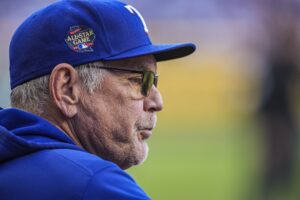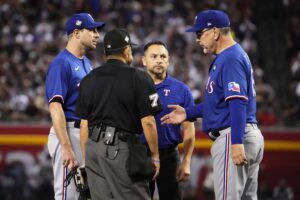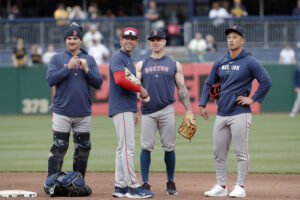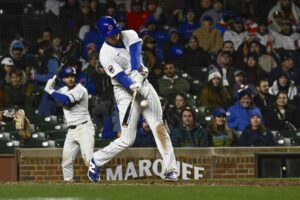The Atlanta Braves are entering yet another season where they are not expected to compete. Atlanta has been rebuilding since the end of the 2014 season, and a number of trades during the process have produced varied results. Some of the trades worked incredibly well for the franchise, but others have fallen short of expectations. As fans get ready for another season looking toward the future, here is a breakdown of three trades where the Braves would like to have a do-over.
Three Atlanta Braves Trades That Haven’t Worked Out
Traded closer Craig Kimbrel and OF Melvin Upton Jr. to the San Diego Padres for OF Jordan Paroubeck, OF Cameron Maybin, OF Carlos Quentin, P Matt Wisler, Draft pick
The Braves made it clear following the 2014 season that a rebuild of the organization was needed. Some of the first Braves stars to get shipped off in the process were Jason Heyward and Justin Upton. Those trades were tough blows to fans, but it appeared Atlanta was done wheeling and dealing (for the time being) as the start of the 2015 season approached. Then this trade happened.
At the time, this trade was praised as a huge win for the Braves, and rightfully so. Atlanta had found a way to rid itself of the massive contract owed to the under-performing Upton. Furthermore, paying Kimbrel to man the back end of a bullpen for a 70-win team did not make much sense. Clearing the money associated with the players and getting a few prospects in return, along with a draft pick, seemed like a slam dunk for Atlanta. How did this trade turn out to be a loss?
One aspect that changed the outcome of this trade, and something outside of Atlanta’s control, is the fact that the price of relief pitching rose dramatically in the seasons following this trade. The trades to send Aroldis Chapman to the Cubs and Andrew Miller to the Indians returned a greater haul of prospects than the Braves received for Kimbrel. One reason for this was the inclusion of Upton in the deal. Erasing his disastrous salary was great for a rebuilding team, but how did Atlanta use those funds?
In reality, the Braves used the majority of that money in signing an aging Nick Markakis to a four-year, $44 million deal. The signing was a big head-scratcher for a rebuilding team and has turned out to be a poor decision over the life of the deal. Atlanta has not competed with Markakis on the roster while he has produced three seasons just above replacement level in terms of WAR.
The players acquired by Atlanta have also not produced much to this point. Maybin turned in one solid season before being trading to the Detroit Tigers for two relievers. Quentin never played in Atlanta and was merely included in the deal to balance out the money taken on by San Diego. Paroubeck was shipped off for an international signing bonus slot, and Wisler has posted a 5.26 ERA in 67 appearances in Atlanta. Additionally, one of Atlanta’s issues since 2014 has been the bullpen, an area that Kimbrel’s presence would undoubtedly improve.
The only potential saving grace for this trade is the fact that the draft pick acquired was used to select 3B Austin Riley. Riley is currently ranked as Atlanta’s No. 9 prospect and is one of the few power prospects in the organization. He has the makings of a player that could develop into a special talent and an everyday third baseman. Still, getting one valuable piece in return for one of the game’s best closers, along with the mishandling of funds saved from the deal, has to be considered a miss at this point in time.
Traded P Bronson Arroyo, P Luis Avilan, P Jim Johnson, P Alex Wood, and INF Jose Peraza to the Los Angeles Dodgers for P Zachary Bird, RP Paco Rodriguez, INF Hector Olivera, and Draft Pick
The decision to trade Upton and Kimbrel made some sense at the time, but the decision to acquire Olivera from the Dodgers in a massive move was a confusing one from the start. Unfortunately for the Braves, the results turned out more disastrous than anyone could have imagined.
Atlanta had fallen in love with Olivera’s potential and believed he would be the perfect right-handed power bat to complement Freddie Freeman in the lineup. However, the issues were evident from the start. Olivera was a 30-year old prospect without a single MLB game under his belt, a funky swing, and was tasked by the Braves with learning how to play third base. Whether the pressure, expectations, and changes created a perfect storm or not may never be known, but what is known is that Olivera didn’t last long with the Braves. He appeared in 30 games over the end of the 2015 season-start of the 2016 season before an arrest led to his suspension.
Atlanta would trade Olivera in a deal for Matt Kemp later that season, ending his brief time in a Braves uniform. He has yet to return to MLB. Of the other players acquired in the deal, Bird is no longer in Atlanta’s organization, and Rodriguez, viewed as a valuable reliever at the time, never pitched for the Braves after undergoing Tommy John Surgery. The draft pick received was used on talented LHP prospect Joey Wentz, but it will still be a little while before he is looking at a MLB debut.
The biggest asset that Atlanta lost in the deal would have to be Wood. Pitching with the Dodgers in 2017, Wood went 16-3 with a 2.72 ERA and 151 strikeouts in 152.1 innings pitched. While there are some health concerns about his arm, he remains a solid performer that can serve both as a starter and reliever.
While the other assets included in the deal produced varying results, it is hard to declare this trade anything more than a disaster for the Braves. These players did have value then and could have been used in other areas than to acquire an untested prospect on the wrong side of 30. Once again, the draft pick, in the form of Wentz, is the saving grace for this deal. And while he does look to be special, it is always a long and trying path for pitching prospects to reach the big leagues.
Traded RPs David Carpenter and Chasen Shreve to the New York Yankees for LHP Manny Banuelos
It does not feel fair to comment on any trade involving Banuelos, but it must be discussed for transparency sake. Banuelos was an ultra-talented pitching prospect that had drawn rave reviews from around the league while coming up. Unfortunately, he underwent Tommy John Surgery and missed all of 2013 as a result and never seemed to be the same after.
Atlanta decided to take a chance on Banuelos ahead of the 2015 season and traded two relievers for him. For what its worth, he had a fantastic debut and a couple of very strong starts, but his numbers in seven appearances were not great. Additionally, he once again battled arm issues and was later released in August of 2016.
In terms of outgoing players from the deal, Carpenter turned in one below average season between New York and Washington in 2015 and has not appeared in MLB since. The lone player from the deal that retains any sort of value is Shreve. It must be stated that Shreve is not an All-Star at this point in his career, but he has turned in two solid seasons of relief work since leaving Atlanta. He would certainly help the Braves bullpen, and that is why this trade goes down as a loss.
With all that being said, the Banuelos trade is definitely one where the front office gets a pass. This was the sort of high-risk, high-reward trade that inevitably happens a few times throughout a rebuild. Obtaining a talent like Banuelos for two relievers is relatively unheard of, and that’s a roll of the dice that should be taken 99% of the time.
(Be sure to check out the first article in this three-part series that looks at three trades for Atlanta that turned out great for the Braves.)
Main Photo:
Embed from Getty Images






